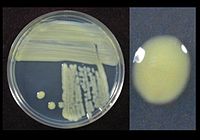
Photo from wikipedia
Although cultivars possessing recessive resistance alleles provide effective control bacterial of spot of pepper (Capsicum annuum), the currently deployed resistance gene, bs5, is ineffective against Xanthomonas gardneri (Xg), one of… Click to show full abstract
Although cultivars possessing recessive resistance alleles provide effective control bacterial of spot of pepper (Capsicum annuum), the currently deployed resistance gene, bs5, is ineffective against Xanthomonas gardneri (Xg), one of the pathogenic species. Resistance against Xg was identified in C. annuum accession PI 163192, and this study sought to characterize this novel resistance and to map the resistance gene(s) to the pepper genome. We crossed PI 163192 with the susceptible cultivar, Early Calwonder (ECW), to develop resistant near-isogenic lines (NILs) of ECW, designated ECW80R. The novel resistance in ECW80R was determined to be quantitative, recessively inherited, and non-HR causing, and inhibits lesion expansion and chlorosis. Presence of the resistance in NILs decreased the in planta bacterial population by 9-fold compared to ECW. Bulked segregant analysis (BSA) of resistant and susceptible individuals from an F2 population using whole genome single nucleotide polymorphisms identified a major resistance locus within an approximately 6 Mb interval on the sub-telomeric region of chromosome 11. We developed markers spanning this region and used these to genotype backcross F2 populations, which further delimited the resistance locus within a 2.3 Mb interval. The novel resistance locus has been designated bs8. ECW80R and the linked markers developed in this study should prove useful for breeders seeking to advance this resistance into commercially-relevant germplasm and for pyramiding bs8 with other resistance alleles such as bs5 and bs6. bs8 will help prolong the durability of bacterial spot resistance in pepper and improve resistance to multiple species of Xanthomonas.
Journal Title: Phytopathology
Year Published: 2022
Link to full text (if available)
Share on Social Media: Sign Up to like & get
recommendations!